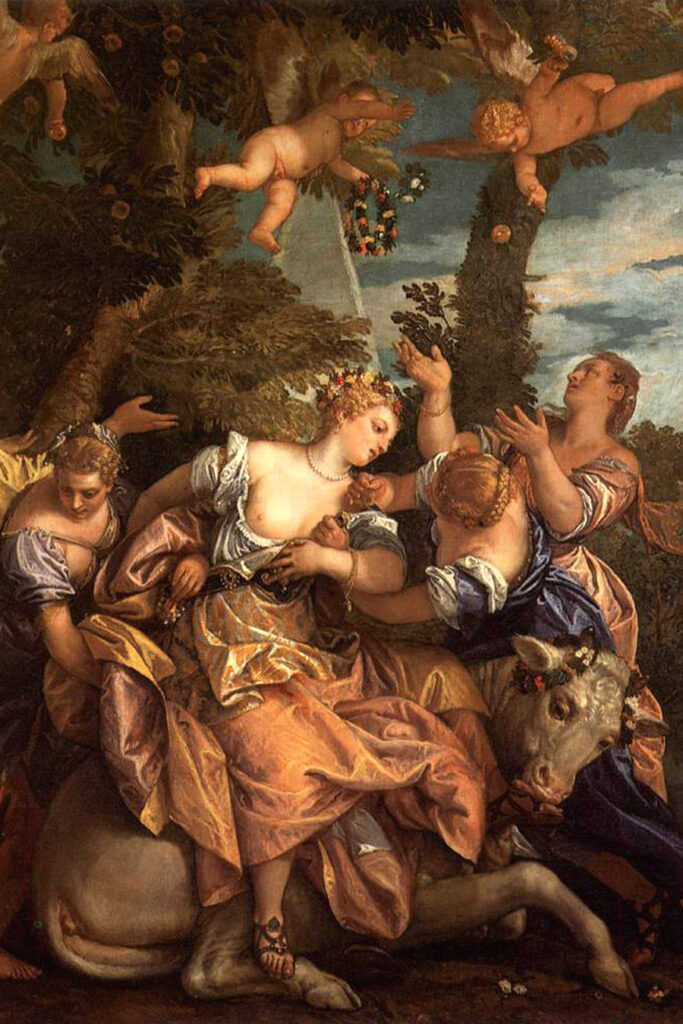
Ancient legends and mythology tell us Zeus first saw the Phoenician princess Europa at her home in Tyre, Lebanon. At that moment, she was walking beside the sea gathering wildflowers, and he immediately fell in love with her. In the Roman poet Ovid’s description of their encounter, Zeus. . . .
. . . . headed for the shore, where the great king’s daughter, Europa, used to play together with the Tyrian virgins. Royalty and love do not sit well together, nor stay long in the same house. So the father and ruler of the gods, who is armed with the three-forked lightning in his right hand, whose nod shakes the world, setting aside his royal sceptre, took on the shape of a bull. [He] lowed among the other cattle, and, beautiful to look at, wandered in the tender grass.
In colour he was white as the snow that rough feet have not trampled and the rain-filled south wind has not melted. The muscles rounded out his neck, the dewlaps hung down in front, the horns were twisted, but one might argue they were made by hand, purer and brighter than pearl. His forehead was not fearful, his eyes were not formidable, and his expression was peaceful. Agenor’s daughter marvelled at how beautiful he was and how unthreatening.
But though he seemed so gentle she was afraid at first to touch him. Soon she drew close and held flowers out to his glistening mouth. The lover was joyful and while he waited for his hoped-for pleasure he kissed her hands. He could scarcely separate then from now. At one moment he frolics and runs riot in the grass, at another he lies down, white as snow on the yellow sands. When her fear has gradually lessened he offers his chest now for virgin hands to pat and now his horns to twine with fresh wreaths of flowers.
The royal virgin even dares to sit on the bull’s back, not realising whom she presses on, while the god, first from dry land and then from the shoreline, gradually slips his deceitful hooves into the waves. Then he goes further out and carries his prize over the mid-surface of the sea. She is terrified and looks back at the abandoned shore she has been stolen from and her right hand grips a horn, the other his back, her clothes fluttering, winding, behind her in the breeze.
Ovid, Metamorphoses Book II: 844-875
The Legend of Europa Continued in Crete
Once they arrived on Crete, the Zeus and Europa became lovers. She then gave birth to three children, including Minos who became the first king of the Minoans. This great and beautiful Minoan civilization left many bequests for the Classical Greeks who followed. And the name of this Phoenician princess was given to the entire new continent, which was called Europe.
The complete stories of the Phoenicians of Lebanon, the Minoans of Crete, and their gifts to the Classical Greeks are explored in the book Phoenicians: Lebanon’s Epic Heritage.
The content of this website is drawn from the research of historian Sanford Holst

Updated September 30, 2023
CLOUD: Europa legend, Europa myth, Zeus, Bull, Minoans

Further information
If you would like to experience more of the Phoenician world than you find in these short articles, see the book Phoenicians: Lebanon’s Epic Heritage. This extensive exploration is brightened with 104 illustrations.
Going beyond the few traditionally-cited facts, this authoritative work draws from discussions with leading archaeologists and historians to discover new clues and lines of inquiry into this secretive society.
Phoenicians
You can take a look inside this book. See the first pages here.
